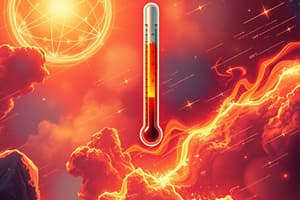Podcast
Questions and Answers
What is the correct formula for wave speed?
What is the correct formula for wave speed?
- v = λ / f
- v = f + λ
- v = T / f
- v = f × λ (correct)
How is frequency defined in the context of waves?
How is frequency defined in the context of waves?
- The time taken for one complete oscillation
- The distance between two consecutive crests
- The maximum displacement from rest position
- The number of oscillations per second (correct)
What characterizes transverse waves?
What characterizes transverse waves?
- They can travel through a vacuum without a medium
- They consist of oscillations that are not repetitive
- Particle motion is parallel to energy propagation
- They have particles moving perpendicular to energy propagation (correct)
What is the relationship between time period and frequency?
What is the relationship between time period and frequency?
What phenomenon occurs when a wave changes direction upon entering a different medium?
What phenomenon occurs when a wave changes direction upon entering a different medium?
Which of the following accurately describes the medium in wave propagation?
Which of the following accurately describes the medium in wave propagation?
What is the primary cause of sound production?
What is the primary cause of sound production?
What range of frequencies can humans typically hear?
What range of frequencies can humans typically hear?
What does the horizontal axis (X-axis) on a CRO display represent?
What does the horizontal axis (X-axis) on a CRO display represent?
How does a higher time base setting affect the CRO display?
How does a higher time base setting affect the CRO display?
How is the amplitude of a waveform determined on a CRO?
How is the amplitude of a waveform determined on a CRO?
What is the formula used to calculate frequency from the time period?
What is the formula used to calculate frequency from the time period?
When observing a waveform on a CRO, how can you determine the time period?
When observing a waveform on a CRO, how can you determine the time period?
What does adjusting the 'Volts/Div' knob do on a CRO?
What does adjusting the 'Volts/Div' knob do on a CRO?
What does diffraction refer to in wave behavior?
What does diffraction refer to in wave behavior?
What is the purpose of the trigger function on a CRO?
What is the purpose of the trigger function on a CRO?
How can wavelength be determined from a waveform on a CRO?
How can wavelength be determined from a waveform on a CRO?
How is the cursor function beneficial on modern oscilloscopes?
How is the cursor function beneficial on modern oscilloscopes?
What information can be derived from the amplitude of a waveform?
What information can be derived from the amplitude of a waveform?
If the time period of a signal is measured as 5 ms, what is the frequency?
If the time period of a signal is measured as 5 ms, what is the frequency?
If a wave spans 4 divisions on the Y-axis at a gain of 0.5 V/div, what is the amplitude?
If a wave spans 4 divisions on the Y-axis at a gain of 0.5 V/div, what is the amplitude?
Which of the following steps is NOT involved in reading a signal on the CRO?
Which of the following steps is NOT involved in reading a signal on the CRO?
What is the expected behavior of waves passing through a large aperture?
What is the expected behavior of waves passing through a large aperture?
How do small apertures affect wave diffraction?
How do small apertures affect wave diffraction?
Which situation depicts low levels of diffraction?
Which situation depicts low levels of diffraction?
What is the effect of large wavelengths on diffraction when using a small aperture?
What is the effect of large wavelengths on diffraction when using a small aperture?
Which statement best summarizes the relationship between aperture size and wavelength in diffraction?
Which statement best summarizes the relationship between aperture size and wavelength in diffraction?
Flashcards
Frequency
Frequency
The number of oscillations (complete back-and-forth motions) that occur in one second.
Wavelength
Wavelength
The distance between two consecutive crests or troughs in a wave.
Wave Speed
Wave Speed
The speed at which a wave travels through a medium. It is calculated by dividing the distance traveled by the time taken.
Diffraction
Diffraction
Signup and view all the flashcards
Time Period
Time Period
Signup and view all the flashcards
Sound Waves
Sound Waves
Signup and view all the flashcards
Cathode Ray Oscilloscope (CRO)
Cathode Ray Oscilloscope (CRO)
Signup and view all the flashcards
Refraction
Refraction
Signup and view all the flashcards
What is a Cathode Ray Oscilloscope (CRO)?
What is a Cathode Ray Oscilloscope (CRO)?
Signup and view all the flashcards
What does the X-axis on a CRO represent?
What does the X-axis on a CRO represent?
Signup and view all the flashcards
What does the Y-axis on a CRO represent?
What does the Y-axis on a CRO represent?
Signup and view all the flashcards
What is the Time Base on a CRO?
What is the Time Base on a CRO?
Signup and view all the flashcards
What is the Voltage Scale on a CRO?
What is the Voltage Scale on a CRO?
Signup and view all the flashcards
What is Frequency?
What is Frequency?
Signup and view all the flashcards
What is Time Period (T)?
What is Time Period (T)?
Signup and view all the flashcards
What is Amplitude?
What is Amplitude?
Signup and view all the flashcards
What is Wavelength?
What is Wavelength?
Signup and view all the flashcards
What is the Cursor Function on a CRO?
What is the Cursor Function on a CRO?
Signup and view all the flashcards
What is the Trigger Function on a CRO?
What is the Trigger Function on a CRO?
Signup and view all the flashcards
What is Amplitude?
What is Amplitude?
Signup and view all the flashcards
What is Frequency?
What is Frequency?
Signup and view all the flashcards
What is the Time Period?
What is the Time Period?
Signup and view all the flashcards
How does a higher time base affect the signal?
How does a higher time base affect the signal?
Signup and view all the flashcards
How does a lower voltage scale affect the signal?
How does a lower voltage scale affect the signal?
Signup and view all the flashcards
What is diffraction?
What is diffraction?
Signup and view all the flashcards
What factors affect diffraction?
What factors affect diffraction?
Signup and view all the flashcards
How does wavelength affect diffraction?
How does wavelength affect diffraction?
Signup and view all the flashcards
How does the size of an opening affect diffraction?
How does the size of an opening affect diffraction?
Signup and view all the flashcards
How does diffraction explain why we can hear sound but not see around corners?
How does diffraction explain why we can hear sound but not see around corners?
Signup and view all the flashcards
Study Notes
SI Units
- Hertz (Hz) is the unit for frequency (cycles per second)
- Meters (m) is the unit for distance (wavelength)
- Seconds (s) is the unit for time
- Meters per second (m/s) is the unit for speed (wave speed)
Terminology and Definitions
- Oscillations are repeated back-and-forth motions.
- Vibrations are rapid particle movements within a medium.
- Frequency is the number of oscillations per second, measured in Hertz (Hz).
- Wavelength is the distance between consecutive crests or troughs.
- Speed is the rate of wave travel, measured in meters per second (m/s).
- Energy propagation is the movement of energy through a medium as waves.
- Medium is the material that a wave travels through (e.g., air, water).
- Amplitude is the maximum displacement from rest position (related to wave height).
- Time period is the time for one complete oscillation, measured in seconds.
Transverse Waves
- Particle motion is perpendicular to energy propagation (up and down motion).
- Examples include light waves, water waves, and waves on a string.
Longitudinal Waves
- Particle motion is parallel to energy propagation (back and forth motion).
- Examples include sound waves, shock waves, and pressure waves.
Wave Equation
- Wave speed (v) equals frequency (f) multiplied by wavelength (λ).
- Formula: v = f × λ
Time Period/Frequency
- Time period (T) is the time for one oscillation.
- Formula: T = 1 / f
- Frequency (f) is the number of oscillations per second.
- Formula: f = 1 / T
Wave Behaviour
- Reflection is when a wave bounces off a surface.
- Refraction is when a wave changes direction passing from one medium to another (due to a change in speed).
- Diffraction is when waves spread out passing through a gap or around obstacles.
- Diffraction is more pronounced with smaller apertures and larger wavelengths.
Sound
- Sound is produced by vibrating objects and needs a medium to transmit.
- Sound speed is calculated as speed = distance/time.
- A practical technique involves using two microphones to measure sound velocity.
- The human hearing range is approximately 20 Hz to 20,000 Hz.
- Noise is unwanted or unpleasant sound.
Cathode Ray Oscilloscope (CRO)
- CROs are used to measure time period (one complete oscillation) by using the time base setting.
- Frequency can be calculated using f = 1 / T.
- CROs can display waveforms of various sound sources, including musical instruments.
Types of Waves in a Ripple Tank
- Reflection, refraction, and diffraction behaviours are observed similar to other wave types.
Reading a CRO
Understanding the Display
- The CRO displays waveforms with:
- Horizontal axis (X-axis): representing time (ms or μs per division)
- Vertical axis (Y-axis): representing voltage (V or mV per division)
Adjusting Controls
- Time base (X-axis): Adjust the rate at which the signal moves, affecting the scale (higher/smaller values for higher signals, lower/larger for slow signals)
- Voltage (Y-axis): Adjusts to vertically compress/stretch the waveform according to the voltage scale.
Reading the Signal
- Frequency: Measured by the time period (T) for one cycle, using the formula f= 1/T
- Amplitude: Measured from the baseline to the peak or trough of the wave.
- Wavelength: Found by counting the horizontal divisions between crests and multiplying by the time base setting.
Cursor Function
- Modern oscilloscopes feature a cursor function allowing for direct measurement of time periods and amplitudes.
Triggering
- Crucial for stable waveform display by synchronizing the waveform.
Determining Values
Amplitude
- Step 1: Observe the vertical scale markings (mV/div or V/div).
- Step 2: Count the vertical divisions from baseline to peak.
- Step 3: Multiply the number of divisions by the gain to get amplitude.
Time Period
- Step 1: Observe the horizontal scale markings (ms/div or s/div).
- Step 2: Count the horizontal divisions for one complete cycle.
- Step 3: Multiply the number of divisions by the time base to get time period.
Frequency
- Use the formula: f = 1 / T
Formulas Summary
- Amplitude = Number of divisions × Gain
- Time Period (T) = Number of divisions × Time Base
- Frequency (f) = 1 / Time Period (T)
Studying That Suits You
Use AI to generate personalized quizzes and flashcards to suit your learning preferences.




